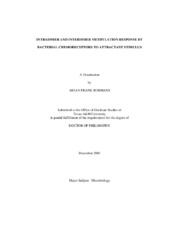| dc.description.abstract | This study focuses on the mechanism of transmembrane signaling by Tar, the aspartate chemoreceptor of Escherichia coli. Like other bacterial chemoreceptors, Tar localizes to the cell membrane and relays information about the external chemical environment through the membrane to a cytoplasmic signaling domain. The output of the signaling domain controls the directional bias of the rotary flagellar motors of the cell. Net movement of a cell in a chemical gradient involves temporal comparison of the current concentration with the concentration in the recent (a few seconds) past. The current concentration is measured as the percent occupancy of the extracellular ligand-binding domain of the receptor, and the past is represented by the extent of covalent methylation of four conserved glutamyl residues in the cytoplasmic domain. Under steady-state conditions, the methylation level corresponds to ligand occupancy. Tar is a dimer, and much evidence suggests that dimers associate into trimers of dimers. Higher-order arrays of receptors form in the presence of the cytoplasmic proteins CheA and CheW. The conformational change generated by ligand binding is transmitted through the membrane by one subunit of a dimer. To examine whether this initially asymmetric signal becomes symmetric within the cytoplasmic domain, I examined aspartate-induced adaptive methylation of the two subunits of mutant Tar receptor heterodimers. In the presence of CheA and CheW, adaptive methylation after addition of aspartate was symmetric, but in their absence, although the level of methylation increased, the rates were different for the two subunits. I also found that cross-talk, at the level of adaptive methylation, occurs between different receptor types even in the absence of CheA and CheW. These results provide support for the idea that a tight association of receptor dimers within trimers of dimers allows for an actively signaling receptor to affect the methylation state, and thus presumably the signaling state, of receptors within a trimer that are not bound to an attractant ligand. | en |


